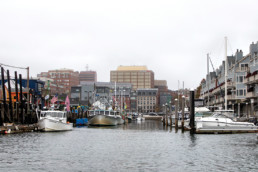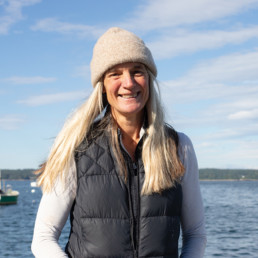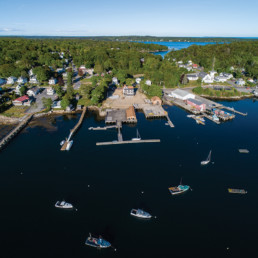Karen Sanford on the shore in South Portland, looking westerly at Portland’s waterfront. Sanford was a leader in the effort to preserve working waterfront access after condominiums were built on a pier.
PHOTO: TOM GROENING
The Working Waterfront Wars
Condos on a Portland pier was the shot heard along the coast
By Tom Groening
Karen Sanford had a quiet life planned when she arrived in Portland in the mid-1980s. Earlier, while living in Seattle, she became politically active as that city’s waterfront faced transformation from a diverse, active maritime zone to one dominated by hotels and condos.
Sanford, who now lives in South Portland, moved into Portland’s West End and she remembers looking forward to becoming involved in book clubs and learning to cook lobster. But just as changes were afoot in the Pacific Northwest, developers had their eyes on Maine’s largest city. And she could not stand by and let the working waterfront disappear.
The shot heard along the coast was a condominium project on Central Wharf, later renamed Chandler’s Wharf. For the struggle to preserve access to the water for those who made a living there, it was a kind of Pearl Harbor moment.
The access was lost and remains so today.
“It was the premier pier on the waterfront,” Sanford remembers, with adjacent deep water, protection from prevailing winds, and businesses nearby that supported the fishing industry. There was one upside: it suddenly became easier to rally people to the cause. She remembers many people describing the impetus to oppose nonmarine development: “When I saw those condos…”
Sanford, in joining others who saw the threat, drew on her experience in Seattle, where a broad coalition formed to fight the encroachment of housing and hotels. Fishermen like Willis Spear became the face of the opposition, and powerfully spoke about what was at stake, she says, even recording radio ads.
Sanford and others worked to get a referendum on the city ballot to stop further housing and hotels, and in May 1987, residents voted by a 2-1 ratio to block nonmarine development on the waterfront. It was a landmark victory, but 35 years later, the struggle continues in places like Boothbay Harbor, Rockland, and Southwest Harbor, waterfronts that may have seemed safe from threats back then.

Central Wharf, at right, was transformed from a fishing pier to a condominium development in the mid-1980s, galvanizing opposition to further nonmarine development on Portland’s waterfront.
PHOTO: JACK SULLIVAN
The allure of the condo project wasn’t difficult to understand—people with the means to do so like to live on or near the water. But ironically, the activity of fishing boats they find charming becomes threatened by the transformation.
A report analyzing Portland’s changing waterfront published in 1988 by John Ferland of the University of Rhode Island articulated the dynamic it described as inevitable: “Change [is] caused by whirlwind development flowing north from the eastern megalopolis. While it is too early to draw conclusions on the fate of Maine’s coastline, it is interesting to keep in mind a rule of thumb espoused by one-time State Planning Office economist Lloyd Irland: ‘People invest in attractive places until they are no longer attractive.’”
Ferland, writing 34 years ago, identified the precursor to this investment: “The pumping of millions of taxpayer dollars into economically depressed maritime industries combined with allowing market forces to spur nonmarine development along a small section of the waterfront.”
The succession that Portland witnessed has or will play out elsewhere. Waterfront industry declines, because it either goes overseas or locates inland, no longer able to dump waste into the sea. Artists and craftspeople rent some of the vacant space as inexpensive studios, then galleries open, drawing browsers and buyers. Restaurants and pubs, hoping to extract spending from these people, follow.
It’s not the worst fate for a city like Portland, but people like Sanford try to champion the victims in this transformation.
“It’s really about what’s right,” she asserts, mindful that battles over protecting working waterfront access will never end. “How do we take care of our natural resources? There’s no more important natural resource than our connection to the sea.”
Ferland offered a prediction back in 1988: “Portland’s experience will be useful for other communities, either for successes to be emulated or failures to be avoided.”
Once access points are gone, they do not come back,” was one of several blunt statements included in a report issued in late 2021, researched and compiled by Merritt Carey, a seasonal resident of Tenants Harbor. The report, “The Critical Nature of Maine’s Working Waterfronts and Access to the Shore,” was commissioned by the Island Institute.
There is much at stake, Carey argues, with the lobster industry alone generating more than $1 billion in economic activity, according to a 2018 Colby College study. “Considerable growth” in aquaculture, coupled with a healthy scallop fishery, and the less visible but steady harvests of groundfish, clams, seaweed, and worms, means pressure by users will not abate, she writes.

It’s not just fishermen and ocean farmers who benefit from access.
“Those who flock to our shores to consume lobsters and steamers, to visit our oyster trail, who stand mesmerized as they watch fishermen unload their catch” also benefit from the working waterfront, Carey writes.
“Any way you measure, whether raw economic data, heritage and history, or community, Maine’s working waterfront and our ability to earn a living on the water is integral to who we are, and who we should be,” the report asserts.
Carey concludes that rather than defending access harbor by harbor, a statewide action plan with an agency with teeth is needed.
Boothbay Harbor has been characterized by tourism-based businesses for generations, but a recent development threatened fishing access. An older, shorefront motel had ceased operating, and a proposal was made by a wealthy newer resident to purchase and demolish the building and rezone the motel property and more of the shore to allow for retail and other uses. That part of the shore included a privately owned working waterfront access point.
More than $5.5 million was raised privately to purchase the property under the auspices of a working waterfront preservation nonprofit. That group plans a waterfront park and “working waterfront hub” on the parcel. Had the original zoning change proposal been approved, fishermen would have had to scramble for access.
The Boothbay Harbor story highlights a key component of the threat: much of the access to the water is privately owned. These privately owned access points “have long provided overland access to the shore … on a handshake,” Carey notes in her report. When these properties are sold to those with no relationship with users, access is lost.

The former site of Cap’n Fish’s Motel on the east side of Boothbay Harbor; the motel closed in 2019, but the community gathered to create Boothbay Harbor Waterfront Preservation, the nonprofit organization that is funding the construction of a public park in the 1.4 acre lot, which will preserve working waterfront access.
PHOTO: JACK SULLIVAN
Carey’s report also notes the domino effect that follows loss of access:
“A single clammer without access…will use an airboat. The noise will likely lead to bad relations with neighbors and waterfront owners…[which] leads to competition for space and resources.” What follows are crowded boat launches and wharves, she writes.
Another pressure comes as out-of-staters decide to buy a home near the shore. Several years ago, the Maine Sea Grant program at the University of Maine developed brochures to be distributed to real estate agents in Harpswell and Jonesport-Beals, both active fishing ports. The brochures were to be given to would-be buyers, reminding them that the picturesque lobster boats bobbing at anchor during cocktail hour come with some less-charming realities—trucks passing through at 4 a.m., diesel boat engines revving a little later, and the stink of rotting bait on the pier next to pleasure boats.
With COVID bringing even more interest in the Maine coast from out-of-state house buyers—as much as 25 percent of sales in 2021—traditional working waterfronts may face more opposition.
The coast-wide fight to save the working waterfront won a substantial victory that came in a change to the state’s constitution. Maine’s property tax system, like that of most states, assesses taxes based on the real estate value of a property. This means a waterfront lot—perhaps including an unpaved parking area and a small wharf—on which a hotel might be built was assessed at the higher, not current use value. The higher property tax bill tends to spur the owner to sell or develop.
In November 2005, Mainers approved a constitutional amendment dictating that waterfront properties be taxed at the value of their current use. It passed with 72% of voters supporting the measure.
But that didn’t eliminate threats, and work continues on other fronts.
Sam Belknap’s family has owned and operated a commercial fishing wharf in Round Pond on the Pemaquid Peninsula since the early 1950s. His grandfather purchased it then with some trepidation, Belknap said, because “at that time, no one really recognized the value of working waterfronts.”
Belknap, a senior community development officer with the Island Institute who focuses on working waterfront preservation, says the threat today is the same as it was in the mid-1980s: “Development for nonmarine uses.”
The pandemic has accelerated this development, he says. “Maine has become a safe haven, a place of refuge and respite.” There is another component to this pressure, though. “Now you layer the real threat of climate change on top of that.”
Aquaculture is growing, in part as a hedge against uncertainty in the lobster fishery, which is impacted by warming waters. Federal concern about right whales comes in part because the mammals’ food source is moving, again because of warming waters.
And a final worry for the fishing industry is the push to develop offshore wind turbines as a means of moving away from fossil fuels.

Combined, Belknap says, “they are chronic stressors.”
Rather than a wave of development pressure crashing up the coast, “Now, it’s popped up from York to Eastport, in discrete events.”
The Island Institute is committed, he added, to preserving working waterfront access because it serves as the backbone of so many island and coastal communities.
The state’s Land for Maine’s Future Fund now identifies working waterfronts as worthy of preserving and it pays for, through outright purchase or deed restrictions, maintaining access. The statewide nonprofit Maine Coast Heritage Trust also has added working waterfronts to its preservation focus. Both changes represent a substantive evolution in mission, reflecting the urgency.
In Portland, a hotel, restaurant, and retail proposal for another part of the waterfront stirred opposition quickly in 2019. A Waterfront Alliance formed to advocate for fishing and other interests, and that group continues to meet and monitor waterfront matters.
But even as awareness of the fragility of waterfront access has increased, policy makers have also begun seeing that blanket fixes are not always appropriate. In Portland, for example, some parts of the waterfront were zoned for marine-related or marine-dependent businesses. But how many rope, buoy, and trap shops can make enough to pay the rent? In recent years, some of those restrictions have been eased.
But Portland continues to be a battleground, Sanford and others believe, as hotels and restaurants proliferate. In an op-ed published in the Portland Press Herald in 2017 on the 30th anniversary of the referendum vote, Sanford issued her report card, giving low grades on the city’s “hot pursuit of a huge hotel on the Maine State Pier,” one of only four that are publicly owned. Though it failed to come to fruition, “Hotel dreams die hard, even in already crowded hotel markets,” she warned.
She also criticized the development of the former Cumberland Cold Storage building “into 98,000 square feet of law offices and other non-marine businesses,” and the city approving the former Portland Co. site “into a private, formulaic Faneuil Hall-style hotel, condo, and retail development.”
Sanford gave high marks to the thriving Eimskip-operated shipping port and, farther west, Portland Yacht Services.
Today, Sanford recommends the city hit the pause button for 20 years, if only to see what climate change brings.
“There have to be idle places along the water, sometimes for decades,” she says, “like fallow land on a farm.” Predicting future waterfront-based activity is difficult, she continues, and cites the frenetic pace at which ships were built in Portland and South Portland when the U.S. entered World War II.
“It could be a completely different waterfront in 50 years.”
Tom Groening is editor of Island Journal and The Working Waterfront.






